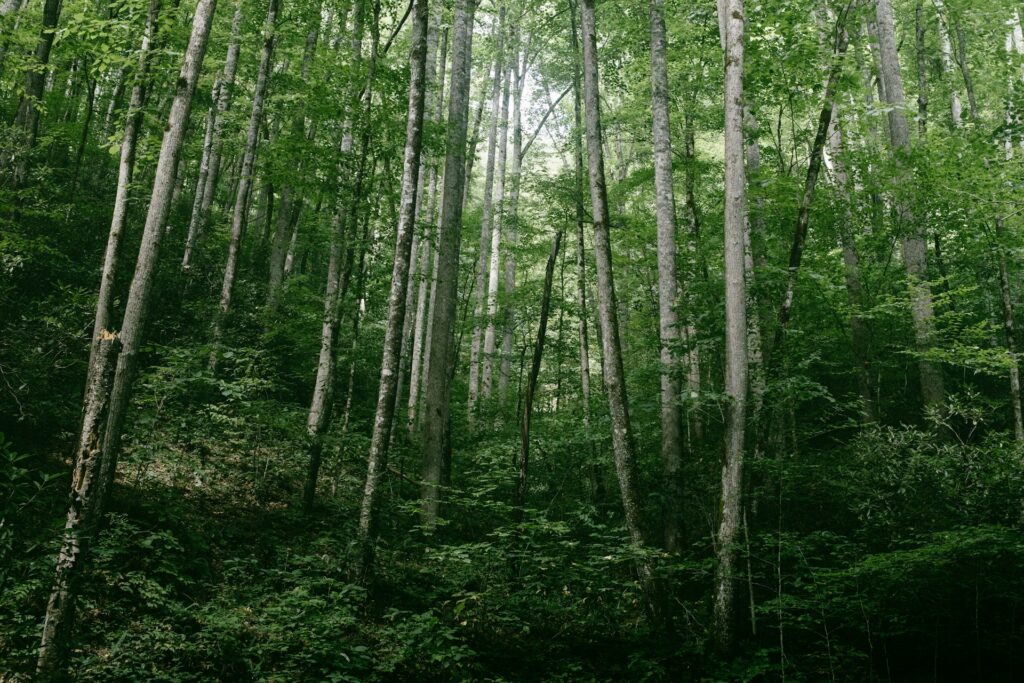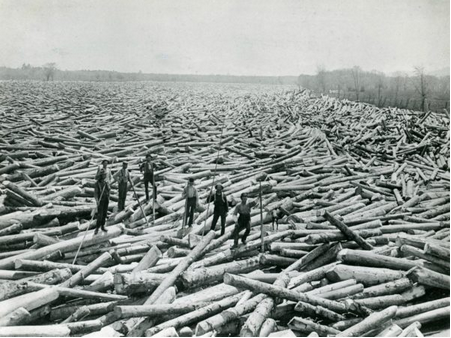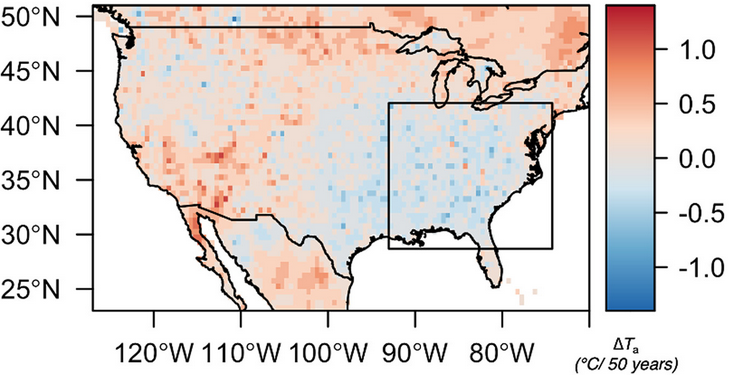Much of the U.S. warmed during the 20th century, but the eastern part of the country remained mysteriously cool. The recovery of forests could explain why
13 February 2024

A century of forest growth likely helped keep the eastern United States cool as the rest of the country warmed, according to a new study in Earth’s Future. Credit: Wes Hicks/unsplash
AGU press contact:
Liza Lester, +1 (202) 777-7494, [email protected] (UTC-5 hours)
Contact information for the researchers:
Kim Novick, Indiana University, [email protected] (UTC-5 hours)
Mallory Barnes, Indiana University, [email protected] (UTC-5 hours)
WASHINGTON — Widespread 20th-century reforestation in the eastern United States helped counter rising temperatures due to climate change, according to new research. The authors highlight the potential of forests as regional climate adaptation tools, which are needed along with a decrease in carbon emissions.
“It’s all about figuring out how much forests can cool down our environment and the extent of the effect,” said Mallory Barnes, lead author of the study and an environmental scientist at Indiana University. “This knowledge is key not only for large-scale reforestation projections aimed at climate mitigation, but also for initiatives like urban tree planting.”
The study was published in the AGU journal Earth’s Future, which publishes interdisciplinary research on the past, present and future of our planet and its inhabitants.
Return of the trees
Before European colonization, the eastern United States was almost entirely covered in temperate forests. From the late 18th to early 20th centuries, timber harvests and clearing for agriculture led to forest losses exceeding 90% in some areas. In the 1930s, efforts to revive the forests, coupled with the abandonment and subsequent reforestation of subpar agricultural fields, kicked off an almost century-long comeback for eastern forests. About 15 million hectares of forest have since grown in these areas.
“The extent of the deforestation that happened in the eastern United States is remarkable, and the consequences were grave,” said Kim Novick, an environmental scientist at Indiana University and co-author of the new study. “It was a dramatic land cover change, and not that long ago.”
During the period of regrowth, global warming was well underway, with temperatures across North America rising 0.7 degrees Celsius (1.23 degrees Fahrenheit) on average. In contrast, from 1900 to 2000, the East Coast and Southeast cooled by about 0.3 degrees Celsius (0.5 degrees Fahrenheit), with the strongest cooling in the southeast.
Previous studies suggested the cooling could be caused by aerosols, agricultural activity or increased precipitation, but many of these factors would only explain highly localized cooling. Despite known relationships between forests and cooling, studies had not considered forests as a possible explanation for the anomalous, widespread cooling.
“This widespread history of reforestation, a huge shift in land cover, hasn’t been widely studied for how it could’ve contributed to the anomalous lack of warming in the eastern U.S., which climate scientists call a ‘warming hole,’” Barnes said. “That’s why we initially set out to do this work.”
Trees are cool
Barnes, Novick and their team used a combination of data from satellites and 58 meteorological towers to compare forests to nearby grasslands and croplands, allowing an examination of how changes in forest cover can influence ground surface temperatures and in the few meters of air right above the surface.
The researchers found that forests in the eastern U.S. today cool the land’s surface by 1 to 2 degrees Celsius (1.8 to 3.6 degrees Fahrenheit) annually. The strongest cooling effect occurs at midday in the summer, when trees lower temperatures by 2 to 5 degrees Celsius (3.6 to 9 degrees Fahrenheit) — providing relief when it’s needed most.
Using data from a network of gas-measuring towers, the team showed that this cooling effect also extends to the air, with forests lowering the near-surface air temperature by up to 1 degree Celsius (1.8 degrees Fahrenheit) during midday. (Previous work on trees’ cooling effect has focused on land, not air, temperatures.)

Loggers in the Hudson Valley. Source: Adirondack History Museum
The team then used historic land cover and daily weather data from 398 weather stations to track the relationship between forest cover and land and near-surface air temperatures from 1900 to 2010. They found that by the end of the 20th century, weather stations surrounded by forests were up to 1 degree Celsius (1.8 degrees Fahrenheit) cooler than locations that did not undergo reforestation. Spots up to 300 meters (984 feet) away were also cooled, suggesting the cooling effect of reforestation could have extended even to unforested parts of the landscape.
Other factors, such as changes in agricultural irrigation, may have also had a cooling effect on the study region. The reforestation of the eastern United States in the 20th century likely contributed to, but cannot fully explain, the cooling anomaly, the authors said.
“It’s exciting to be able to contribute additional information to the long-standing and perplexing question of, ‘Why hasn’t the eastern United States warmed at a rate commensurate with the rest of the world?’” Barnes said. “We can’t explain all of the cooling, but we propose that reforestation is an important part of the story.”
Reforestation in the eastern United States is generally regarded as a viable strategy for climate mitigation due to the capacity of these forests to sequester and store carbon. The authors note that their work suggests that eastern United States reforestation also represents an important tool for climate adaptation. However, in different environments, such as snow-covered boreal regions, adding trees could have a warming effect. In some locations, reforestation can also affect precipitation, cloud cover, and other regional scale processes in ways that may or may not be beneficial. Land managers must therefore consider other environmental factors when evaluating the utility of forests as a climate adaptation tool.
***
Notes for Journalists:
This study is published in Earth’s Future, an open-access journal. Neither the paper nor this press release is under embargo. View and download a pdf of the study here.
This study is part of an ongoing special collection, “Quantifying Nature-based Climate Solutions,” from AGU’s publications.
Paper title:
“A Century of Reforestation Reduced Anthropogenic Warming in the Eastern United States”
Authors:
- Mallory L. Barnes (corresponding author), Indiana University, Indiana, USA
- Kim Novick (corresponding author), Indiana University, Indiana, USA
- Quan Zhang, Wuhan University, Wuhan, China
- Scott M. Robeson, Indiana University, Indiana, USA
- Lily Young, Indiana University, Indiana, USA
- Elizabeth A. Burakowski, University of New Hampshire, New Hampshire, USA
- Christopher. Oishi, USDA Forest Service, North Carolina, USA
- Paul C. Stoy, University of Wisconsin-Madison, USA
- Gaby Katul, Duke University, North Carolina, USA
AGU (www.agu.org) is a global community supporting more than half a million advocates and professionals in Earth and space sciences. Through broad and inclusive partnerships, we advance discovery and solution science that accelerate knowledge and create solutions that are ethical, unbiased and respectful of communities and their values. Our programs include serving as a scholarly publisher, convening virtual and in-person events and providing career support. We live our values in everything we do, such as our net zero energy renovated building in Washington, D.C. and our Ethics and Equity Center, which fosters a diverse and inclusive geoscience community to ensure responsible conduct.
#
Contributed by Gabriella Lewis
